Travels with Grace: Canada, 1924 (Part 1)
Welcome to the next segment of our 2019 #TravelTuesday series: Traveling with Grace. Today Grace and her family head into British Columbia and Alberta, Canada.
Victoria
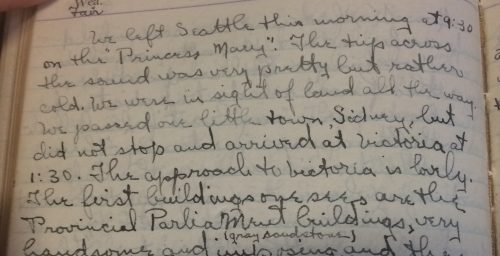
August 11, 1924: We left Seattle this morning at 9:30 on the “Princess Mary.” The trip across the sound was very pretty but rather cold. We were in sight of land all the way. We passed one little town, Sidney, but did not stop and arrived at Victoria at 1:30.
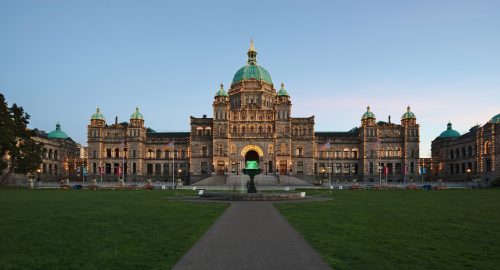
The approach to Victoria is lovely. The first buildings one sees are the Provincial Parliament buildings (gray sandstone), very handsome and imposing and the ivy covered red brick Empress Hotel (the porch framed in yellow and purple flowers with large baskets of [unreadable] some hanging between the arches, lobelia and lady slipper) where we are stopping, which is directly opposite the wharf. Victoria, the largest city on Vancouver Island has a population of 34,000; 5,000 of which are Chinese. The only industries are lumber, an iron foundry and machine shop. It is a pretty, old-fashioned city much frequented by tourists and this hotel reminds me of an old English country home in the midst of lovely gardens. Image credit: by Dllu – Own work, CC BY-SA 4.0.
August 12, 1924: This morning we started out for a ride at 10 o’clock going thru the business section where there are some pretty small shops, early English china and Irish linens, two or three department stores (Spencer’s and Hudson Bay Co. the nicest) and large office buildings. We saw some pretty tho modest homes in the outskirts of town, followed the Gorge past the Colwood race track, golf links, Langford Lake, a little summer colony, [unreadable] harbor and oyster beds, the Gold stream and out along the Island Highway which winds up along the Malahat Mt. range (Indian name for very high), to an altitude of 1200 ft. overlooking Saanich Arm, a little island known as Robinson Crusoe, Saanich Peninsula and beautiful wooded hills. We saw mallard ducks in the marshes and navy blue grouse along the way. The air up here is balmy and exhilarating.
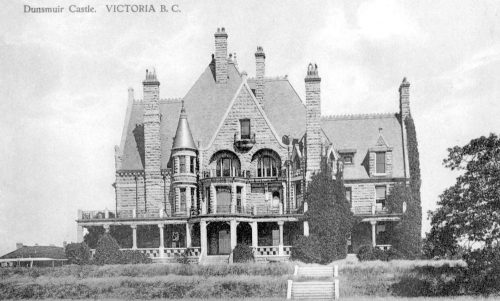
Dunsmuir Castle, Victoria, BC, c. 1920. Courtesy of the BC Archives.
We saw an ancient building or rather the remains of one which was the home of Sir James Douglas, first governor general of Canada and the first Hudson Bay fur trading building in B.C. This afternoon we took a ride thru the better residential streets passing Dunsmuir Castle (the man who discovered coal on this island) the house of the Lt. Governor and many of the beautiful homes in English Tudor and Colonial design with a few bungalows here and there. Rode thru Beacon Hill Park, along the rock-bound coast of the straits of San Juan de Fuca with the snowy crests of the Olympics visible on the opposite shore in Wash.
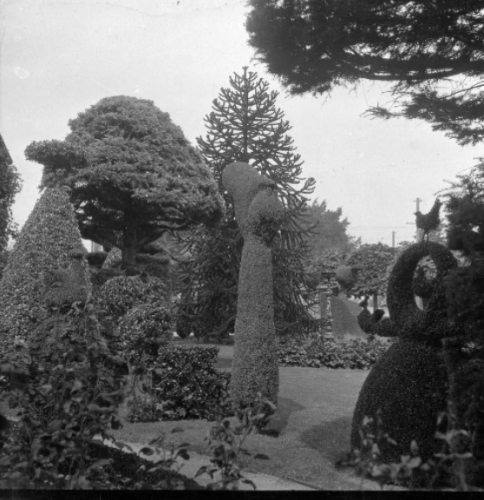
Topiary Garden. Pendray’s Gardens, Victoria, B.C., 1925. Keystone-Mast Collection, UCR/California Museum of Photography, University of California at Riverside.
We rode thru the Oak Bay section and out to Gordon Head, thru hedge bordered country lanes reminiscent of England, past many poultry farms (the fowls run loose in orchards and fields) saw lots of men and women by cycling both in town and country, saw Jap and Chinese truck farms, fine herds of cattle, sheep and goats (they milk the latter extensively). Back in the city we saw Pendray’s celebrated topiary gardens with the hedges cut in designs of birds, animals, and inanimate objects, Pemberton’s rose gardens and rode thru Chinatown, the largest I have yet seen with its schools, theaters, newspapers and churches, and narrow alleys then to Galway’s for dinner followed by a concert in the hotel.
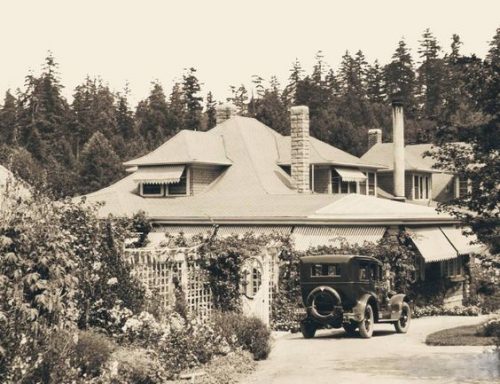
The Butchart family residence at The Butchart Gardens, circa 1920s. Via.
August 13, 1924: This morning we started at 10 o’clock for a ride of an hour and a half to Butchart’s sunken gardens, passing Elk Lake en route where there is a good bathing beach called Hamsterly-Lakeside. Mr. B. has a big cement quarry and the gardens which are laid out on the quarry are his hobby. It is the show place of Victoria. Flowers of every variety are seen in the most picturesque settings and perfect grouping of colors, worked by 10 Japanese gardeners. There are posts and fences around it made of cement to imitate wood. This afternoon we walked thru the spacious gardens of the Empress which are a joy to behold, they are so artistic and well kept. Even the street lampposts here are decorated with flowers, with baskets of geraniums, depending on either side of the cluster lights along Government St. Tonight the Parliament blds. were beautifully illuminated in honor of the teachers’ convention and a scotch band in kilts played on the terrace in front. The view from the hotel is lovely with the light reflected in the sound and the dark mts. looming up in the distances. Reminds me of pictures of Venice.
Vancouver
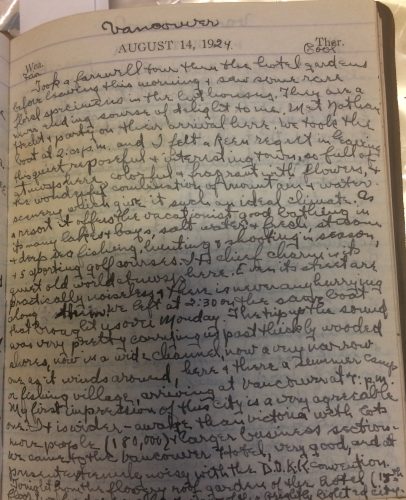
August 14, 1924: Took a farewell tour thru the hotel gardens before leaving this morning and saw some rare floral specimens in the hot houses. They are a never-ending source of delight to me. Met Nathan Hecht and party on their arrival here. We took the boat at 2:00 p.m. and I felt a keen regret in leaving this quiet, reposeful and interesting town, so full of atmosphere, colorful and fragrant with flowers, and the wonderful combination of mountain and water scenery which give it such an ideal climate. As a resort it offers the vacationist good bathing in its many lakes and bays, salt water and fresh, stream and deep-sea fishing, hunting and shooting in season, and 5 sporting golf courses. Its chief charm is its quiet old-world atmosphere. Even its streets are practically noiseless and there is never any hurrying along them.
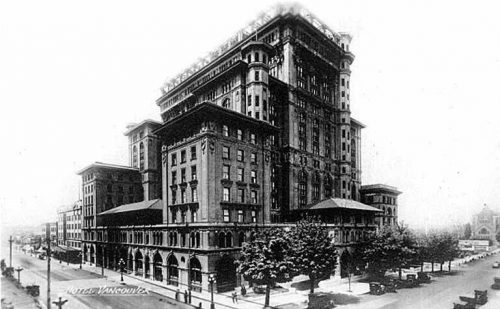
Hotel Vancouver, c. 1923. Courtesy of the University of Washington Libraries Digital Collections from Seattle, WA. Via.
We left at 2:30 on the same boat that brought us over Monday. The trip up the sound was very pretty carrying us past thickly wooded shores, now in a wide channel, now a very narrow one as it winds around, here and there a summer camp or fishing village, arriving at Vancouver at 7 P.M. My first impression of this city is a very agreeable one. It is wider-awake than Victoria with lots more people (180,000) and larger business sections. We came to the Vancouver Hotel, very good, and at present extremely noisy with the D.D.K.K. convention. Tonight from the flowery roof garden of the hotel (15th floor) we had an excellent view of the brightly lighted city.
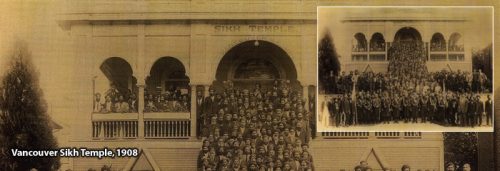
Vancouver Sikh Temple, 1908. Via.
August 15, 1924: Started out at 11 A.M. on a 2 hour motor ride going along Marine Drive, 18 miles of splendid paved roads with deep woods on the one hand and water and mts. on the other. Past English Bay a favorite bathing resort, thru the Kipilano residential district, skirted the University of B.C. campus, circled Point Grey, overlooking Straits of Georgia with the mts. and shoreline of Vancouver is[land] in the distance. Stopped at Lookout Point where we had a good view of the islands and mouth of Fraser river. Then thru the beautiful Shaughnessy Heights, a restricted neighborhood, where the homes are as lovely and diversified as any I have ever seen, that of Maj. Gaul Mc. Roe (originally built for Lord Shaughnessy) being easily the handsomest. The gardens are not the least attractive feature of this section. Before returning to the hotel we made a tour of the Oriental Quarter where a number of Chinese (several thousands), Japs, and Hindus who wear black turbans live. The latter have their own place of worshop, the Sikh Temple all who enter here [must] leave their shoes behind. In the streets we saw many picturesque groups of Chinese and Japanese children, all very friendly, shouting and waving as we passed.
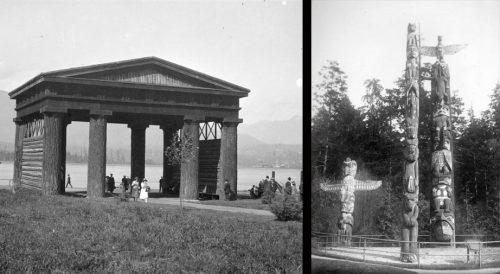
Lumbermans Arch and totem poles, c. 1930s. Via.
This afternoon we took another pretty ride thru Stanley Park, a large natural reserve of over 1000 acres, mostly virgin forest where are many fine specimens of Douglas firs, these huge-girthed straight tapering trees rearing their heads apparently to the sky. Some of the points of interest in the park are as follows: the fountains and [unreadable] animal houses (kangaroos), (Shakespeare and rock gardens) statue of Pauline Johnson, the Indian writer and poetess; the Lumberman’s Arch, constructed by the lumbermen of Vancouver from a single Douglas fir; the 9 o’clock gun which used to act as curfew and is still fired regularly, and a collection of rather interesting Totem Poles, around which it is planned to erect a model Indian village.
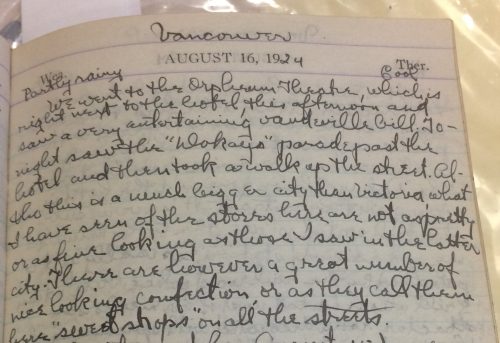
August 16, 1924: We went to the Orpheum Theatre, which is right next to the hotel this afternoon and saw a very entertaining vaudeville boll. Tonight saw the “Dokays” parade past the hotel and then took a walk up the street. Altho this is a much bigger city than Victoria, what I have seen of the stores here are not as pretty or as fine looking as those I saw in the latter city. There are however a great number of nice looking confection or as they call them here “sweet shops” on all the streets.
August 17, 1924: It is raining hard today but we can not complain as this is the first time in 75 days that the rain has interfered with our pleasures, heretofore we have only seen a shower once or twice from boat or train. The “Dokays” have gone and the hotel is very quiet by contrast. It is a very substantial sort of place, the lobby reminds me of a railway station, especially as it is patrolled by the railroad police. The Indian Grill where we eat most of our meals is an attractive room decorated with specimens of the taxidermist’s art. This evening was passed most pleasantly in the company of Mr. and Mrs. M.S. Strouse of Balto. and the Binzwangers of Richmond, and in listening to a beautiful concert which was broadcasted from the hotel.
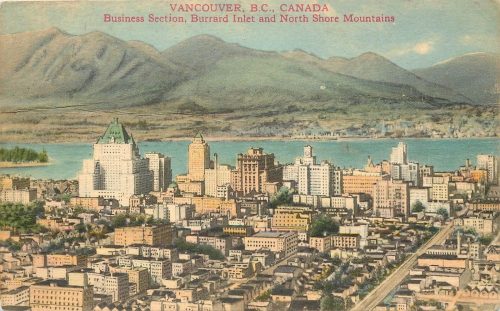
Vancouver, B.C., Canada. Business Section, Burrard Inlet and North Shore Mountains, c. 1920s. Via.
August 18, 1924: Took a very pretty ride this afternoon crossing Burrard Inlet on the ferry to north Vancouver then paralleling the Capilano River to first and second canyons, a long narrow bridge suspended on cables spanning the river at the former point. We passed an Indian (Government) reservation, saw a curious little house, the house of a Fortune teller, in front of which was a funny little garden decorated with a long curling snake made entirely of little green plants edged in yellow with a blue electric light in the eye. Beside this snake was a tiny pond and beside the pond stood a stone cross half submerged in water with the figure of a woman clambering up it. The scenery along the road is mostly rustic, thick ferns, here called bracken and in places growing to a height of 7 and 8 feet. The wild hydrangeas grow here abundantly together with thistles, fireweed and many others of which I know not the names, and alder trees abound which they use for firewood and paper pulp. We arrived at the hotel in time for dinner and took the train for Lake Louise at 8 o’clock. At the C.P.R. depot is a very pretty statue erected by the company in memory of its men lost in the war.
Lake Louise
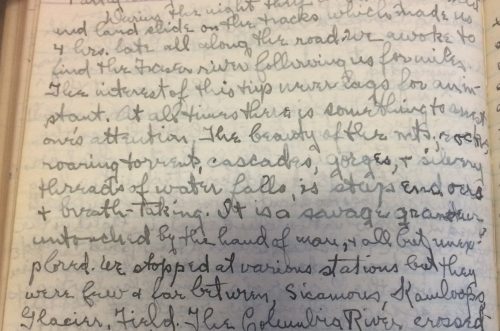
August 19, 1924: During the night there was a big washout and landslide on the tracks which made us 4 hrs. late all along the road. We awoke to find the [unreadable] river following us for miles. The interest of this trip never lags for an instant. At all times there is something to arrest one’s attention. The beauty of the mts., rocks, roaring torrents, cascades, gorges, and silvery threads of water falls, is stupendous and breath-taking It is a savage grandeur, untouched by the hand of man, and all but unexplored. We stopped at various stations but they were few and far between, Sicamous, Kamloops, Glacier, Field. The Columbia River crossed and recrossed our path, always with thunderous road as it rushes over the rocks in its bed. We passed the Swiss Guide’s little village of Edelweiss and had a magnificent view of the Albert gorge and canyon. We sat in the big open observation until the rains drove us is. It cleared just before we reached Lake Louise at midnight and the moon looked out at us on the 3 mile ride to the hotel.
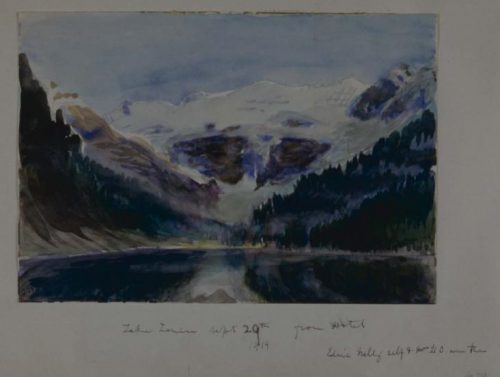
Painting of Lake Louise from Hotel, September 28, 1919 by Viscountess Sybil Rhondda. Courtesy of the BC Archives.
August 20, 1924: The sun shows forth again this morning and we discovered a beautiful Emerald lake in a pearl-crusted setting of mts. as we looked out of our windows. The hotel is plain but comfortable and has a cozy, home-like atmosphere which is a pleasing contract to the one we just left. I took a walk thru the grounds which are intersected by smooth gravel walks bordered with yellow, orange and white poppies, these same poppies forming a thick carpet of golden [unreadable] down the slope to the lake’s rim. Directly opposite the hotel is the snow capped dome of Mt. Lefroy and next Mt. Victoria with the Victoria glacier lying between them an icy rivulet winding its way out from under it. This feeds the lake which in turn floods into another turbulent creek at the opposite end. The snow on the mts. here is thicker and looks much nearer than it did at Mt. Rainier. The Lake itself attracts me more than anything. It is not so large, about a mile and ½ from shore to shore. It’s color is fascinating, constantly changing from emerald to turquoise, deepening to a moss color, then lightening again until it looks like sea foam, and above the sky is azure except where the big white clouds rest close to the summits of the mts. and confound themselves with the snow.
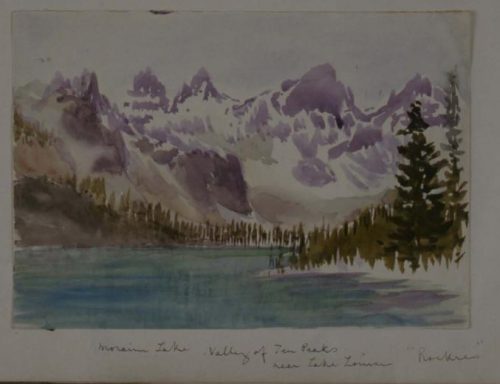
Painting of Lake Moraine, 1919, by Viscountess Sybil Rhondda. Courtesy of the BC Archives.
August 21, 1924: At 10 A.M. we started on a ride to Moraine Lake in the Valley of the Ten Peaks, 9 miles distant from Louise. The tide took us thru the Paradise valley thru which runs Paradise Creek in a series of lovely cataracts. Blue and yellow daisies, fire-weed, white flowers and clumps of green bushes laden with small red berries dot the way and there is no prohibition to pluck them here as at Rainier. Moraine Lake is a long, narrow body of water washing deep in the shadow of ten high pointed peaks all laden with snow, on the one side, and Mt. Temple a solitary block of mt. on the other. It’s position accounts for its peculiar and exquisite coloring being of a clear peacock blue where the light strikes it and a deep aqua-marine in the shadows. There is rowing on this lake as well as at Louise and glaciers are clearly visible between the peaks that fringe it. The place is full of echoes and is quite awesome.
Thanks for reading “Traveling with Grace,” a series where we’re sharing (and annotating) posts from the travel diaries of Grace Amelia Hecht, native Baltimorean, b. 1897 and d. 1955. As mentioned in my introductory post transcription errors sometimes occur and I’ve made my best guesses where possible, denoted by [brackets]. – Rachel Kassman, marketing manager
